Why I Visit Notre Dame Even During the Renovation Closure
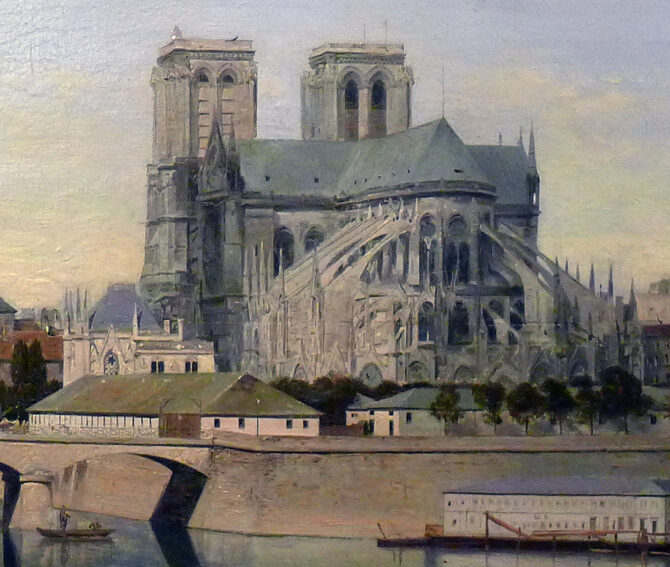
The cathedral is not yet back to her old self, but don’t let that stop you from visiting the grande dame.
Notre Dame won’t reopen until December (restoration work continuing into 2025), but it’s still worth a trip. I’ve been visiting periodically during the last four years and discovered there’s always something new at the site to welcome visitors.
On three sides of the construction site, you can find billboard-type walls that serve not only to guard the lady, but also to tell a story. They are covered with photographs and explanations in French and English. Up until recently, the exhibit showcased excerpts from a National Geographic cover story and photos by Tomas Van Houtryve from the beginning of the reconstruction. (I highly recommend the article.)
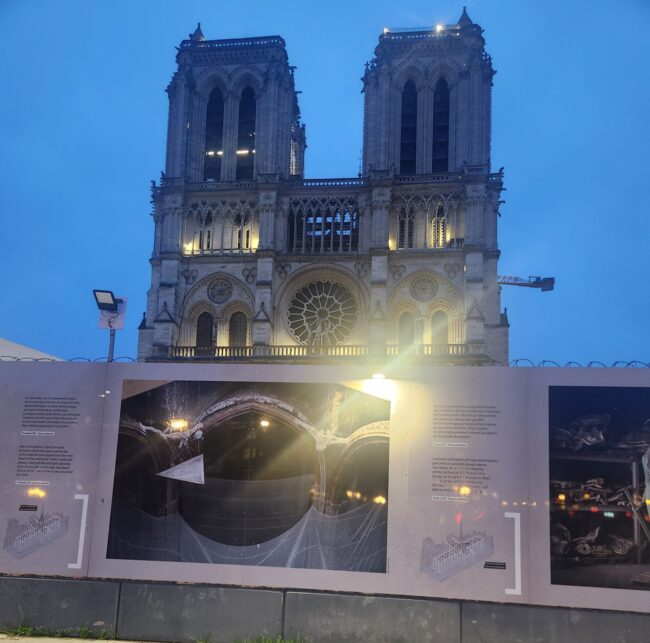
National Geographic exhibit at Notre Dame. Photo: Michele Kurlander
Van Houtryve greatly admired the work that had been done the last time there was a comprehensive renovation – which was in the 19th century when Architect Eugène Viollet-le-Duc oversaw desperately needed repairs. Viollet-le-Duc started in 1844 and worked for 20 years, during which time he installed both the spire and the chimeras. Yes – it was only recently – when its reconstructed spire was delivered to the church for installation in February – that I found out that this part of the structure was barely a century old. Viollet-le-Duc pioneered a new concept of renovation.
I visited Paris in February, and one morning awakened in the dark and threw on my clothing to walk from my Airbnb on rue Mouffetard to Notre Dame before the sun had risen. I got there just as the sky was beginning to lighten and discovered I could now enter the site from the quay on the south – an access point blocked by fencing for much of the time I have been visiting since the April 15, 2019 conflagration.

National Geographic exhibit at Notre Dame. Photo: Michele Kurlander
On the west side, backed against the street, is a group of raised bleacher seats much like in a sports arena, for folks to sit and view the cathedral from that vantage point. A year ago or so, they also opened a walkway to public bathrooms and statuary on the south side. That southern part of the plaza had previously contained a huge pit where debris was tossed as the site was readied for restoration.
For years since the fire, Notre Dame has been surrounded on the north and west by billboard type walls, behind which you could see her top half peeking out. Various exhibits have displayed photos and information about the fire and the restoration. (Now, the array of information has also spread to the south wall.)
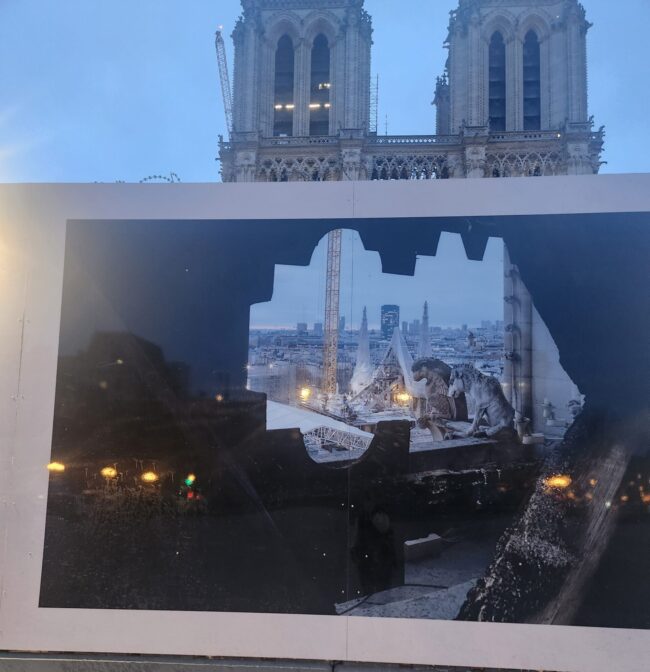
National Geographic exhibit at Notre Dame. Photo: Michele Kurlander
This has been a long journey and an emotional one. I will never forget April 15, 2019, when my phone and inbox both began exploding with messages from all who knew about my adoration for Paris. I turned on my TV and saw in awful color the horror of the flames and, shortly, the iconic spire falling to the ground!
I called my friend Raluca and when she told me she was only a few streets away, and had not yet heard, I stayed on the phone as she ran towards the quay and turned her phone’s video receiver towards the cathedral. We watched together for a while – saying little. What was there to say? Later, I cried as the spire lit up with the flames, tilted, and then fell to the ground.
As I made my Paris visits in 2021-2022, I recall my excitement that an entire wall (the west wall) was covered with cartoons by various artists depicting elements of the work. This exhibit has since been taken down, but I still have copies of the photos, including a cartoon of some workers discussing the renovation.
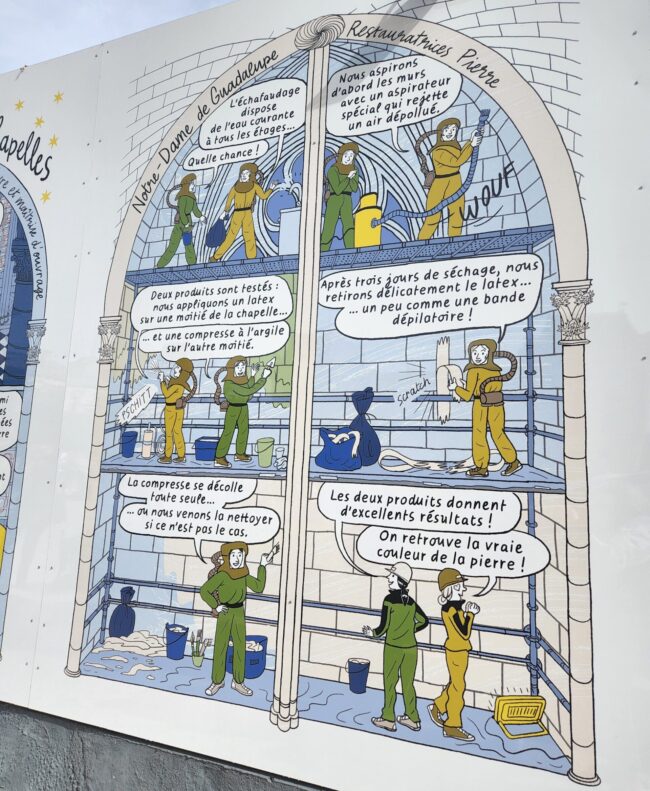
Cartoon exhibit at Notre Dame. Photo: Michele Kurlander
Here is a photo I took in February of the spire, still surrounded by white scaffolding, taken from the window of my favorite Notre Dame viewing location – the lovely little Cafe Panis on Quai Montebello.

Spire seen from Cafe Panis. Photo: Michele Kurlander
Heres a Youtube video of the scaffolding being removed, revealing the new golden rooster on the spire.
In the National Geographic article, I learned much about the history of the building, and its destruction and reconstruction over the centuries. Previously displayed around the cathedral, Van Houtryve’s photos are wonderful, including a photo of the huge hole created when the spire was destroyed – taken from above – and a photo of a headless statue. In each case, the most interesting thing about the photos is Van Houtryve’s verbiage.
For example, he says about the headless statue that, miraculously, all of the statues from the base of the spire had been removed for cleaning just prior to the fire and this statue was “uniquely charged with symbolism. When he designed Notre Dame’s spire, Eugène Viollet-le-Duc put his own facial features on this statue of Saint Thomas.”
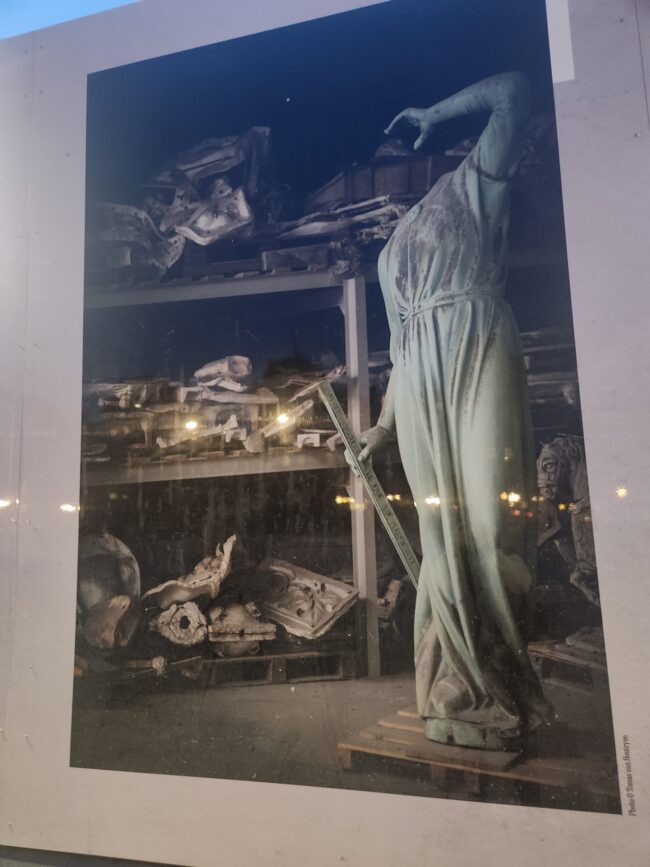
National Geographic exhibit at Notre Dame. Photo: Michele Kurlander
Also, I learned that Van Houtryve has been so fascinated by a 19th-century portrait of Viollet-le-Duc that he decided to study collodium photography – the method used for that photo, which had recently at the time replaced daguerrotype. Van Houtryve used a special camera to take all of his photos with that method! Because of that, all of the portraits he took of people working on the restoration required that his subjects stand absolutely still for eight seconds.
Soon after I entered the site last February, I found a large area with diagrams and verbiage telling me how collodium photography is done and some of his portraits – here is a photo of that information, along with a photo taken by Van Houtryve of one of the workers – making this personage standing there just a couple of years ago seem to be from another century.
The work will not be completed until December, but I have been visiting Notre Dame periodically during the last four years and discovered that each time there is something new and exciting to welcome me and teach me more about her history and what it is going on behind the construction walls.
Friends of Notre-Dame de Paris
Founded in 2017, Friends of Notre-Dame de Paris is the official nonprofit organization in the United States raising funds to support the restoration and preservation of Notre-Dame Cathedral, which has not had major repairs since the mid-1800s. Since its inception, Friends of Notre-Dame de Paris has been hard at work, building a community of Friends in the United States and raising funds to complete the most crucial stages of the reconstruction efforts. Notre-Dame Cathedral’s renovation works are prioritized according to the areas at greatest risk, starting with the spire, the roof, and the choir, followed by the sacristy, the transept, the nave, and the towers. Work cannot begin on new projects until funding is secured for the entire project. The support and generosity of American donors and the dedication of the Friends of Notre-Dame de Paris community will help make the restoration of this cultural heritage monument possible.
To learn how you can contribute to saving Notre-Dame de Paris, visit:
https://www.friendsofnotredamedeparis.org/
Lead photo credit : Notre-Dame during the renovation of 1845-1863. Émile Harrouart, around 1860 - Musée Carnavalet


